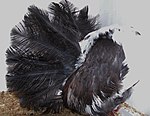Fantail pigeon

The Fantail is a popular breed of fancy pigeon.[1] It is characterised by a fan-shaped tail composed of 30 to 40 feathers, abnormally more than most members of the pigeon family, which usually have 12 to 14 feathers.[2] The breed is thought to have originated in Pakistan, India, China or Spain. There are several subvarieties, such as the English Fantail, the Indian Fantail, and the Thai Fantail. Charles Darwin used it as one of the examples in the first chapter of On The Origin Of Species.

There is a feather mutation called Silky that gives an interesting lace effect to a Fantails tail feathers.[1] Fantails with this mutation are known as Silky or Lace Fantails.
Fantails are often used by pigeon flyers in the training of racing pigeons and Tipplers. They are used as droppers in that they are placed on the loft landing board as a signal to the flying birds to come in and be fed.
Thai Fantail
Note: This section needs serious grammatical revision.
This breed was first introduced by an international breeder named Darwin Charles. This breed was so fine and beautiful,they are similar to Indian fantails, but the difference is that they are pure white and their tails have a ribbon like stripe of other colors. Sadly it is extremely hard to breed them outside of Thailand,Only a few people have bred a Thai Fantail outside Thai borders.In Pakistan's city Lahore a fantail breeder's son (ehtisham) introduced this breed in Pakistan, He did this by pairing a male with black colored male and brown colored female of different breeds and have successfully produced chicks of Thai fantail whereby he named them striped Thai fantail (one has red stripes and the other has black stripes). Nowadays he is trying to make a large colony of this breed.[citation needed]
See also
References
- ^ a b Levi, Wendell (1977). The Pigeon. Sumter, S.C.: Levi Publishing Co, Inc. ISBN 0-85390-013-2.
- ^ Seymour, Colin (Ed) (1995). Australian Fancy Pigeons. A.N.P.A. (Australian National Pigeon Association).
- Darwin, Charles (2003). The Origin of Species. Signet Classic. ISBN 0-451-52906-5. On Google Print
